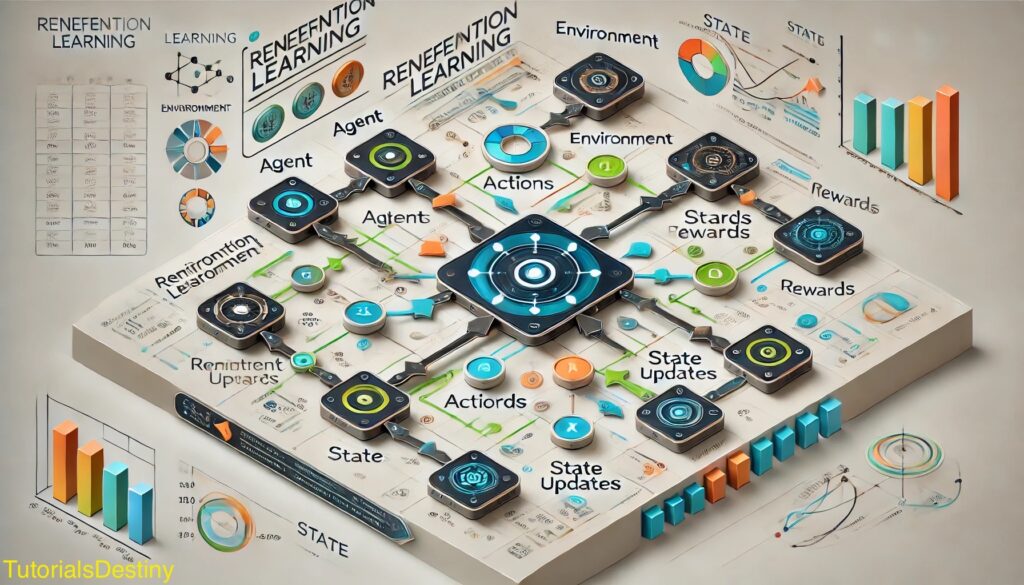
Applications of Reinforcement Learning in Robotics and Gaming
Reinforcement Learning (RL) is a powerful branch of machine learning where an agent learns to take actions in an environment to maximise a cumulative reward. By leveraging trial-and-error-based learning, RL has become integral in solving dynamic, complex, and interactive problems across various domains. Among these, robotics and gaming are two of the most significant and impactful areas.
Reinforcement Learning in Robotics
Robotics involves creating intelligent systems that can perceive, decide, and act autonomously in real-world settings. RL is widely used in robotics for enabling robots to learn optimal behaviors from experience.
Use Cases in Robotics
1. Autonomous Navigation
Robots often need to traverse unknown or dynamic environments without predefined maps. RL enables robots to learn navigation strategies by exploring the space and avoiding obstacles.
• Example: Drones use RL algorithms to navigate through crowded urban areas, avoiding collisions while delivering packages.
• Case Study: Google’s self-driving car project uses RL to improve route optimisation and real-time decision-making.
2. Robotic Manipulation
Industrial and service robots require precise object manipulation. RL allows them to adapt to new objects and environments without explicit programming.
• Example: Factory robots learn to pick and place objects with varied shapes and weights.
• Case Study: OpenAI’s robotic hand learned to solve a Rubik’s Cube using RL, showcasing advanced dexterity and problem-solving.
3. Dynamic Motion Control
Robots such as humanoids or quadrupeds must learn to balance, walk, run, or even perform complex acrobatics. RL helps these robots learn efficient motion strategies.
• Example: Boston Dynamics’ robots use RL to adjust to uneven terrains dynamically.
• Case Study: The DARPA Robotics Challenge saw RL being used in humanoid robots for disaster response tasks.
4. Human-Robot Collaboration (HRC)
RL facilitates smooth interaction between robots and humans by enabling adaptive learning of cooperative tasks.
• Example: Robots in Amazon warehouses learn to coordinate with humans for efficient order processing.
• Case Study: Toyota uses RL to develop robots that assist elderly individuals in performing daily activities.
5. Healthcare Robotics
In healthcare, precision and adaptability are crucial. RL is being used for surgical robots and patient monitoring systems.
• Example: Robots like Da Vinci Surgical System learn to enhance the accuracy of minimally invasive surgeries.
• Case Study: RL-driven robots assist in physical therapy by adapting exercises based on patient feedback.
Reinforcement Learning in Gaming
Gaming has been a playground for testing and advancing RL algorithms due to the structured environments, clear reward mechanisms, and complex strategic tasks. RL has transformed both the development and the experience of gaming.
Use Cases in Gaming
1. Game AI Development
Game developers use RL to create smarter and more adaptive non-player characters (NPCs) that offer a challenging yet enjoyable experience.
• Example: In FIFA games, RL helps create opponents that adapt to a player’s gameplay style.
• Case Study: OpenAI’s Dota 2 bot defeated professional players by learning teamwork and strategy using multi-agent RL.
2. Adaptive Difficulty Levels
RL helps games dynamically adjust their difficulty based on the player’s skill, ensuring engagement without frustration.
• Example: Games like Candy Crush tweak level difficulty in real time to keep players hooked.
• Case Study: Adaptive difficulty in Ubisoft’s Assassin’s Creed franchise ensures players face a balanced challenge throughout.
3. Procedural Content Generation (PCG)
RL enables the automatic creation of game levels, maps, and quests that adapt to a player’s progress.
• Example: Minecraft uses RL to generate complex terrains tailored to the player’s gameplay.
• Case Study: No Man’s Sky uses RL to create endless planetary systems with unique features.
4. Training Simulations
RL agents are used to simulate complex scenarios in strategy games to train players or test game mechanics.
• Example: In StarCraft II, RL agents develop advanced strategies that mimic human-like gameplay.
• Case Study: DeepMind’s AlphaStar achieved grandmaster level in StarCraft II, showcasing superior adaptability.
5. Automated Game Testing
RL-based bots can simulate millions of gameplay sessions to test game mechanics, identify bugs, and balance features.
• Example: Testing an open-world RPG for potential exploits using RL agents.
• Case Study: RL is employed in EA Sports to refine gameplay in FIFA and Madden NFL.
Key RL Algorithms Used in Robotics and Gaming
• Q-Learning: For simple task-solving with discrete actions.
• Deep Q-Networks (DQN): Combines deep learning with RL for tasks like vision-based control.
• Proximal Policy Optimisation (PPO): For stability in continuous action spaces.
• Multi-Agent RL (MARL): For collaborative or competitive multi-agent systems.
Challenges in RL for Robotics and Gaming
1. High Computational Costs: Training RL models, especially in real-world robotics, requires significant computational resources.
2. Sim-to-Real Gap: Transitioning RL models trained in simulations to real-world environments can lead to failures.
3. Safety Concerns: Exploratory learning in RL can lead to unsafe actions, especially in robotics.
Future Directions
• Cross-Domain Applications: Applying gaming RL models to robotics and vice versa.
• Explainable RL: Developing interpretable models for better decision-making insights.
• RL in Metaverse Gaming: Creating intelligent, adaptive NPCs in virtual worlds.
• Cloud-Based RL for Robotics: Using cloud infrastructure to train complex RL models for robotic systems.
Conclusion
Reinforcement Learning has revolutionised robotics and gaming by introducing adaptability, intelligence, and autonomy. From enabling drones to navigate urban landscapes to creating AI agents that outsmart human players, RL continues to unlock the potential of artificial intelligence in real-world and virtual domains. As algorithms evolve and computational power grows, the applications of RL in robotics and gaming will only expand, driving innovation across industries.